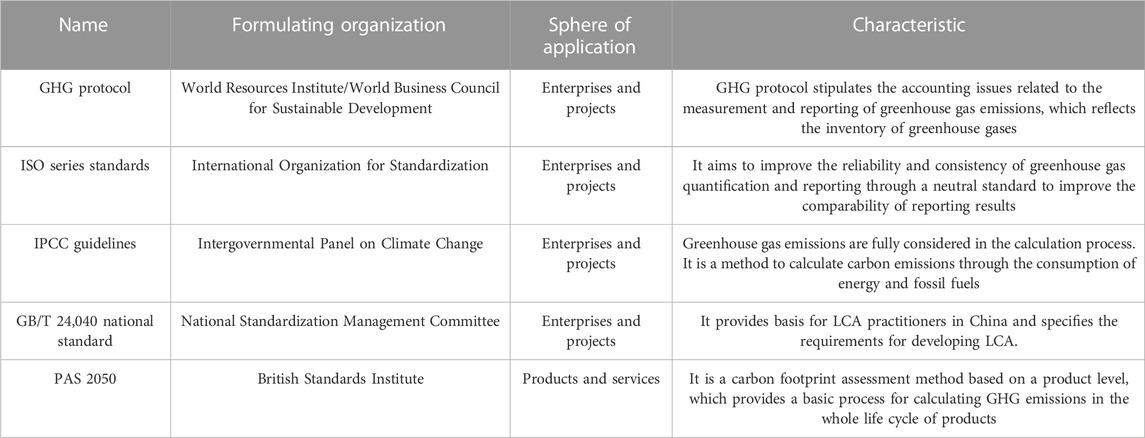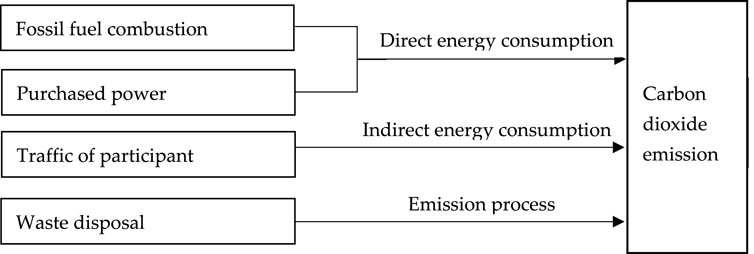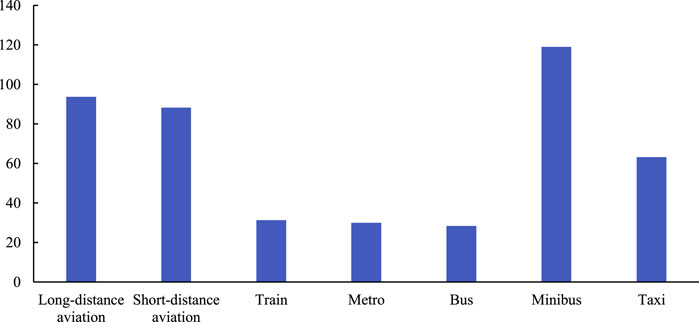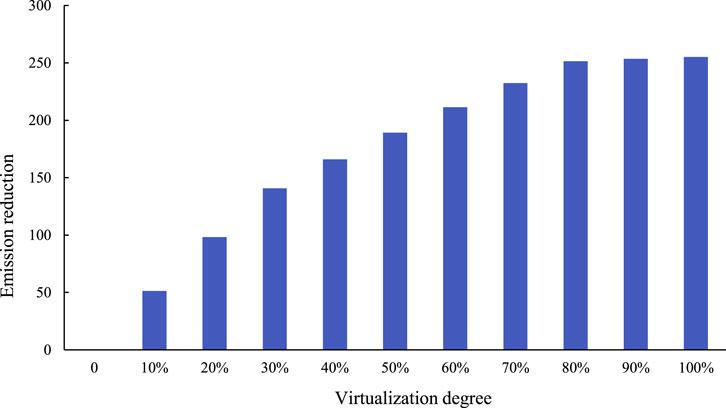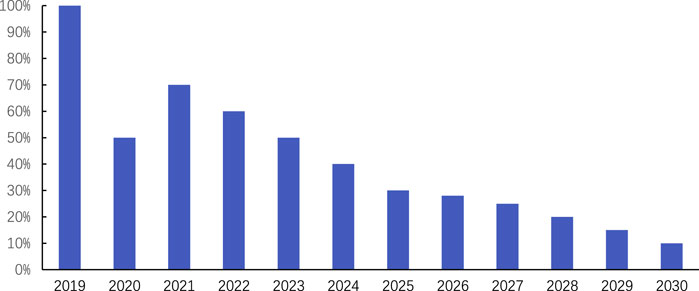- 1College of Arts, Xiamen University, Xiamen, China
- 2China Center for Energy Economics Research, School of Economics, Xiamen University, Xiamen, China
- 3MOE Key Laboratory of Econometrics, School of Economics, Xiamen University, Xiamen, China
Greenhouse gas emissions from human activities have become the leading cause of climate problems. Reducing greenhouse gas emissions from human economic activities and realizing carbon neutralization are the main means of sustainable economic development. Among them, carbon emission reduction of large-scale activities including auctions bears the brunt. Through the emission factor method, this paper estimates the carbon footprint of a typical artwork auction and divides the auction market into different sizes, according to the average round-trip distance of the number of participants. The results show that a typical 3-day medium-sized artwork auction with 500 people’s carbon footprint is about 270 tons of carbon dioxide. The traffic carbon emission of participants accounts for a large proportion of the total carbon footprint, particularly composed of the traffic carbon emissions of a small proportion of long-distance participants. Therefore, the transition from offline to virtual artwork auctions can significantly reduce the carbon footprint by 90%–95%. We put forward suggestions on improving the auction carbon footprint accounting process and industry carbon neutralization system, and promoting the development of relevant technologies for the virtual artwork auction market.
1 Introduction
In November 2021, the World Meteorological Organization released a report on the “global climate situation in 2021” at the 26th United Nations Climate Change Conference. The report data show that the global greenhouse gas concentration reached a new high in 2020, and this growth continued in 2021. Moreover, the global average temperature in 2021 (from January to September) was about 1.09°C, higher than that from 1850 to 1900. At present, it is listed by the World Meteorological Organization as the sixth or seventh warmest year. There will be several climate changes that human beings cannot adapt to (Dillender, 2019). Energy activities are usually the main source of carbon emissions (Levine and Aden, 2008; Kang and Kang, 2022). About 90% of carbon emissions come from energy production and consumption activities in developed countries in 2021 (IPCC, 2021). Sports events (Huang et al., 2012), cultural exchanges (Yates et al., 2022), and other activities are significant sources of energy consumption terminals (Borggren et al., 2013). A lot of energy is consumed from preparation to the holding of large-scale activities. The energy conservation and emission reduction of these large-scale activities are gradually receiving attention.
Since 2006, major events and activities worldwide have taken measures to achieve carbon neutrality. In 2006, the football World Cup in Germany launched an environmental protection plan called “green goal.” The plan was advocated using renewable energy and materials, taking pollution-free public transport, and investing in the treatment of unavoidable pollution. The World Cup finally became the first green international sports event (Dolles and Söderman, 2010). The 2006 Turin Winter Olympics was the first Olympic event that achieved “carbon neutrality.” Carbon dioxide during the Olympics was offset by forestry, energy conservation, and emission reduction and renewable energy plans (Auruskeviciene et al., 2010). By building 5,000 mu of carbon sink forest, the 2010 UN Climate Change Tianjin Conference can achieve “carbon neutralization” because all 12,000 tons of carbon dioxide emitted by the conference can be absorbed by the carbon sink forest in the next 10 years. Since then, the 2014 APEC meeting in China (Tong et al., 2020) and the 2016 G20 summit in Hangzhou, China (Colin, 2016), have achieved “carbon neutrality” through afforestation. In 2022, the Winter Olympic Games held in Beijing minimized carbon emissions through low-carbon venues, low-carbon energy, low-carbon transportation, low-carbon office, and other measures. At the same time, a carbon offset will be realized by utilizing the forestry carbon sink and enterprise donation to ensure the realization of the carbon neutralization goal (Zhao et al., 2021). The estimation of carbon dioxide emissions and the comparison between online and offline forms are helpful in understanding the potential of carbon reduction. We further put forward suggestions on improving the auction carbon footprint accounting process and industry carbon neutralization system, and promoting the development of relevant technologies for the virtual artwork auction market.
Calculating carbon dioxide emissions during major events and conferences is relatively mature, and there are many ways to achieve carbon neutralization. However, in artistic activities, carbon neutralization has not been paid attention to. There is limited research on measuring the carbon footprint of artwork auctions, and few auctions have achieved net-zero emission. China’s art auction market ranks first in the world, according to the China Association of Auctioneers, and by 2020, China had 8,565 artwork auction enterprises and 99,981 auction transactions, with a year-on-year increase of 11.1%. The total business volume of the artwork auction market was 838.705 billion yuan with a year-on-year increase of 15.39%, exceeding the growth rate of the GDP. With the rapid expansion of the auction industry, its accompanying environmental problems should be paid attention to. The general artwork auction needs four stages, namely, auction commission, display, auction, and settlement and delivery, and the duration is longer than that of the general meeting. Like other large-scale activities (Hischier and Hilty, 2002; Dolf and Teehan, 2015; Ewijk and Hoekman, 2021), there will be a lot of energy consumption and carbon dioxide emissions during the artwork auction. The auction has a great potential for emission reduction. The realization of zero net carbon dioxide emissions will significantly promote carbon neutralization. The accounting of the carbon footprint of the artwork auction is helpful in understanding the environmental pressure brought by the auction market and the significance of transforming offline auctions into online carbon neutralization and boosting the realization of carbon neutralization. The research objectives of this paper are as follows. First, identify the carbon emission link of the auction and calculate the carbon emission of the auction. Furthermore, predict the carbon emission trend of the auction in the future based on the accounting results and put forward suggestions on emission reduction measures of the auction industry. This paper expounds the accounting method, scope, and process.
The remainder of the article is organized as follows: in Section 2, a literature review on carbon footprint accounting is presented; in Section 3, the methodology and the empirical result utilized in this study are explained; in Section 4, the future trend is forecasted; and in Section 5, the conclusions and related policy implications are provided.
2 Literature review
2.1 Measurement methodology
A carbon footprint refers to the amount of greenhouse gases produced by a specific activity or entity (Druckman and Jackson, 2009). There are three common carbon footprint measurement methodologies, namely, the input–output method, carbon emission factor, and life cycle methods. The input–output method is mainly based on the input–output table. The direct and indirect carbon dioxide emissions can be estimated according to the direct consumption coefficient and complete consumption coefficient of products (Li et al., 2021). The input–output method takes the whole economic system as the boundary and is suitable for the carbon emission accounting of a macrosystem (Zhu et al., 2012). The IPCC Guidelines described the carbon emission factor method in detail. The overall calculation is that greenhouse gas emissions are equal to the level of activity data multiplied by the carbon emission factor (Sproles, 2009). Determining carbon emission factors is the key to accounting carbon emissions. At present, many scholars calculated the carbon emission factors of different emission subjects, such as energy (Fott, 1999; Spalding-Fecher, 2011), products (Shen et al., 2016), and industry (Huo et al., 2013). There are also many standards and documents that provide reference values of carbon emission factors in various dimensions. The life cycle method refers to analyzing the environmental impacts caused by a product in various stages of production, use, waste, recycling, and reuse (Zobel et al., 2002). The process analysis method which finally quantifies the carbon emission of each process in the life cycle is the carbon footprint calculation method based on a life cycle theory.
The existing carbon footprint research includes macro research and micro research (Table 1). Macro research mainly considers the impact of the international trade and industrial structure (Wang and Zhang, 2021). From a micro perspective, there are many relatively complete carbon emission accounting standards and guidelines in the world and are mainly divided into two categories. One is to calculate the carbon emissions consumed by enterprises or projects, and the other is to calculate the carbon emissions based on the whole life cycle of products or services (Ma et al., 2013). GHG protocol is an enterprise greenhouse gas accounting standard formulated by the World Resources Institute (WRI) and the World Business Council for Sustainable Development (WBCSD), which reduces the repeated calculation of enterprises and projects and reduces the accounting cost (Garcia and Freire, 2014). The Intergovernmental Panel on Climate Change provides the IPCC guidelines on climate change to guide economic sectors in accounting for carbon emissions (Wigley and Raper, 1992). At present, most of the greenhouse gas accounting systems are globally based on IPCC guidelines that have wide applicability. The ISO series standards formulate the specific calculation method of a carbon footprint, oriented to the greenhouse gas emissions and emission reductions in the whole life cycle of goods or services (Garcia and Freire, 2014).
2.2 Activity of carbon footprint accounting
Many scholars use different methods to calculate the carbon footprint of human economic activities. The macro research mainly includes countries, regions, and industries. Hertwish and Peters (2009) analyzed the carbon footprint of countries in the context of globalization and international trade. Herrmann and Hauschild (2009) used the input–output analysis to examine the carbon footprint of trade in developed countries. (Stepchenkova, 2013) used the life cycle assessment method to assess the Norwegian system’s carbon emissions of power transmission. Uvarova et al. (2014) used the IPCC method to analyze the activities related to the oil industry in Russia from 1990 to 2009 and found that the amount of carbon dioxide increased sharply with the increase in energy consumption. Micro research mainly includes products, enterprises, families, and services. The difficulty of research lies in the definition of the scope of carbon footprint accounting. The household carbon footprint is a mature content in carbon footprint research. Lenzen (2001) used the multi-region input–output hybrid LAC approach to construct the German household carbon footprint calculator, accounting for the impact of incomes and scales. Zen et al. (2021) calculated the carbon emissions of Malaysian households in their daily life through investigation and statistics. The results showed that the carbon emissions of households reached 11.76 tons, which was different between urban and rural areas.
For large-scale activities and events, there is also much research dedicated to accurately determining the responsibility subject and accounting scope and accurately calculating the carbon dioxide generated in the process. Hischier and Hilty (2002) calculated the carbon footprint of transportation, conference supplies, and other processes in the 15th international environmental information seminar held in Zurich in 2001 but not considering the energy consumption of accommodation, catering, and conference room. Dolf and Teehan (2015) calculated the carbon footprint of a basketball game at Columbia University in 2011 and systematically considered five categories of items, namely, transportation, accommodation, catering, solid waste, and on-site power consumption into the accounting system. Neugenauer et al. (2020) applied the carbon footprint accounting method of sports events to academic conferences. The accounting scope included conference procurement, power consumption of the conference working group, and other items according to the characteristics of the conference. Achten et al. (2013), Desiere (2015), and Collins and Cooper (2017) all emphasized the carbon footprint accounting of conference activities and transportation. The purpose of carbon footprint accounting is to assess the environment of the activity itself and implement emission reduction measures in the process of an activity and offset the emission of the parts that cannot be reduced. Jckle (2021) compared the carbon footprint of the joint European political research conference held by online meetings and traditional offline meetings and concluded that the carbon footprint of online meetings was reduced by 90% compared with conventional offline meetings and put forward many suggestions on energy conservation and emission reduction in future meetings. Tugcu et al. (2012) assessed the environmental problems of the 2014 FIFA World Cup in Brazil and the 2016 Summer Olympic Games in Rio de Janeiro and believed that the sports institutions and the Brazilian government paid too much attention to the infrastructure of events while ignoring economic, social, and environmental problems. Diederichs and Robers (2016) analyzed the carbon emissions of the 2010 South Africa World Cup and the 17th United Nations Climate Change Conference and discussed how to offset the carbon footprint generated by the two events, as well as the impact of carbon offset methods and carbon neutralization plan on the economy of Durban, South Africa.
Most of the research subjects of the relevant literature are large-scale sports events or academic conferences, and there is hardly any literature studying the carbon emission of artwork auctions. The artwork auction is an important trading channel for artwork. The auction company is entrusted by the client to auction related items and collect parts of the commission. The auctions are a way for auction companies to sell art. Similar to other large-scale events, the preparation and implementation of the auction need to consume a lot of energy and consumables. We analyze the whole process of a typical auction, calculate each segment’s carbon emissions, and understand the carbon emissions of the artwork auction industry. Based on the digital trend of the artwork auction industry, we predicted the changes in the carbon footprint of the artwork auction market in the future.
3 Carbon footprint measurements for auction
3.1 Calculation model
This paper uses the carbon emission factor method to calculate the carbon footprint of the auction, which is a method to calculate the carbon emission through the consumption of energy and fossil fuels. Greenhouse gas emission is the product of activity data and emission factors, as shown in Formula 1
The carbon emission factors related to the auction process in this paper come from various standard documents. The low calorific value of natural gas comes from the China Energy Statistics Yearbook 2011; the low calorific value of other fossil fuels comes from the research on the Chinese greenhouse gas inventory. The carbon content per unit calorific value and carbon oxidation rate comes from the provincial greenhouse gas inventory guidelines (pilot). The power grid emission factor adopts the average national power grid emission factor of 583.9 kg CO2/MWh in the guidelines for accounting methods and reporting of greenhouse gas emissions of enterprises (revised version in 2021) issued by the general office of the Ministry of Ecological Environment. The emission factors of transportation, accommodation, catering, and other related activities refer to 2012 Guidelines to Defra/DECC’s GHG Conversion Factors for Company Reporting: Methodology Paper for Emission Factors issued by the UK Department of environment, food, and rural affairs. The emissions factor of waste disposal refers to the provincial greenhouse gas inventory guidelines (pilot).
3.2 Calculation process
Through the company’s official website, the auction held by Beijing Poly International Auction Co., Ltd. was studied. We found that the auctions generally require a 3-day preview and 1-day auction and that there are about 500 people in the auction (including participants and organizers). So, this paper takes a typical 4-day three-night artwork auction with 500 people as the accounting object.
The implementation guidelines for carbon neutralization of large-scale activities (for Trial Implementation) issued by the Ministry of Ecology and Environment of the people’s Republic of China have strict carbon emission accounting boundaries for the whole process of various large-scale activities. Therefore, based on the document, the emission activities of the artworks auction are divided into fossil fuel combustion, purchased power emission, traffic emission, and waste disposal, as shown in Figure 1. The specific calculation formula is as follows:
Fossil fuel combustion emission refers to the emission of facilities for fossil fuel burning in large-scale event venues and staff offices. A typical 3-day conference will consume 178800 MJ of energy (Hischier and Hilty, 2002). According to China’s greenhouse gas research inventory, the amount of carbon dioxide emitted by using different types of energy will be different (Table 2). The carbon emission factor equals to the carbon content per unit calorific value multiplied by carbon oxidation and 44/12. The carbon content per unit calorific value of anthracite is 27.49
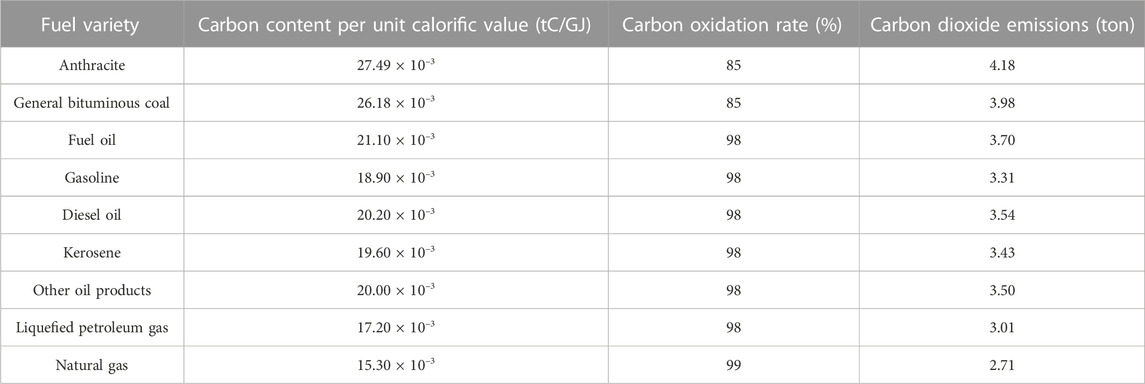
TABLE 2. Carbon content, carbon oxidation rate, and carbon dioxide emission of different fossil fuels.
For the accounting of carbon dioxide generated by net power consumption purchased at the artwork auction, it is necessary to understand the accommodation of power consumption and power emission factors caused by auctions. The power consumption of accommodation is 18.1 Kwh for one person per night (Filimonau et al., 2011). The power consumption of accommodation of a 500-person artwork auction will be 9,050 kW h per day and 27,150 Kwh in the whole process. According to the guidelines for accounting methods and reporting greenhouse gas emissions of enterprises’ power generation facilities (revised in 2021), the national average power emission factor was adjusted from 0.6101 tCO2/MWh in 2015 to the latest 0.5839 tCO2/MWh with a decrease of about 4.3%. According to the latest average emission factor of electricity, the net consumption of electricity purchased at the artwork auction will produce 15.85 tons of carbon dioxide.
Traffic emissions refer to the emission of traffic activities generated by the meeting organizers, participants, and other appropriate personnel who participated in the meeting, such as aircraft, high-speed rail, subway, taxi, and private car. According to the 2012 Guidelines to Defra/DECC’s GHG Conversion Factors for Company Reporting: Methodology Paper for Emission Factors, the default data on CO2 emission parameters of vehicles are as follows. Under the condition of the same distance, the carbon dioxide emitted by a bus travel is the least (Figure 2).
Ewijk and Hoekman (2021) examined several international conferences and found that the average round-trip distance of participants ranged from 1980 km to 9,564 km. Suppose that the average round-trip distance is about 2000 km for a small artwork auction and that 60% of the participants travel by train with an average round-trip distance of 1,000 km and 40% of the participants travel by short-haul air, with an average round-trip distance of 4,000 km. Under the aforementioned assumptions, the traffic emissions of a small artwork auction will reach 80 tons. The average round-trip distance of a medium-sized artwork auction is about 5500 km. Participants mainly take long-distance, short-distance air, and train transportation to the meeting. Moreover, 20%, 50%, and 30% of participants travel by train, short-distance air, and long-distance air with average round-trip distances of 1,200 km, 5,000 km, and 10,000 km, respectively. The carbon dioxide emission generated by transportation is 254.38 tons. For an international large-sized artwork auction with an average round-trip distance of more than 7,000 km, the traffic carbon emission is expected to be 300–450 tons. Notably, the carbon emissions caused by the round-trip transportation of participants accounts for more than 80% of the total carbon emissions of the artwork auction. Also, with the increase in the average round-trip distance of participants, the average carbon emissions per kilometer are also increasing (Table 3).
Through the hypothesis of the medium-sized artwork auction, it is found that 30% of long-distance participants account for more than half of the total traffic emissions, while 30% of short-distance participants account for only about 5% (Figure 3). A small number of long-distance participants account for a large part of the total traffic emissions. Therefore, the traffic carbon emission of long-distance participants is the key to emission reduction. The online artwork auction can enable these long-distance participants to join an auction at home, while short-distance participants’ on-site participation can improve the auction atmosphere, and the artwork auction organizers can offset emissions of short-distance participants at a lower cost.
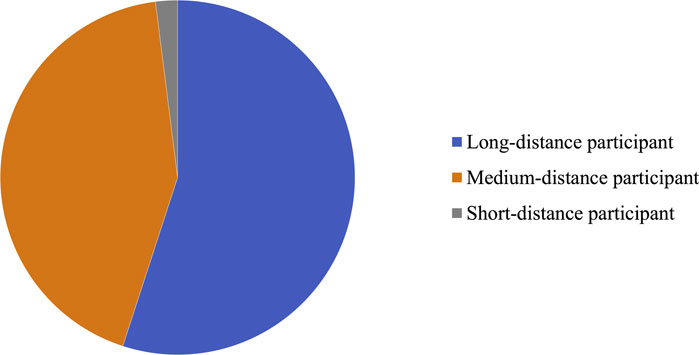
FIGURE 3. Proportion of carbon dioxide emissions of different round-trip distances in a medium-sized artwork auction.
The output of waste is highly related to the number of people. According to the data on domestic waste in major cities in China’s statistical yearbook, the weight of waste treated by landfill is 0.15 kg for one person per day, and the weight of waste treated by incineration is 0.28 kg for one person per day. In the 1-day artwork auction, about 75 kg and 140 kg of domestic waste will be produced and treated by landfill and incineration, respectively. The 4-day three-night artwork auction will have about 645 kg of total wastes, including domestic waste and other types of waste, such as documents and display boards. The weight of waste treated in the landfill, where the greenhouse gas is mainly methane, is about 0.7 tons. The weight of waste treated by incineration is about 1.3 tons, of which the greenhouse gas is primarily carbon dioxide.
The carbon emission factor of landfill treatment is 2.25 and that of incineration treatment is 0.2717. The huge difference is that methane has a high global warming potential. The emission of landfill treatment is about 1.6 tons of carbon dioxide equivalents, and the emission of incineration treatment is about 0.36 tons of carbon dioxide equivalents. In a typical artwork auction lasting 4 days and three nights, the emission from waste treatment is about 2 tons of carbon dioxide equivalents. If the proportion of landfill treatment is reduced and incineration treatment is increased, the carbon dioxide emission will be lower.
To sum up, a typical artwork auction will range from 70 tons to 520 tons. The emission of fossil fuel combustion will range from 2.7 tons to 4.4 tons due to fuels used, of which the emission caused by natural gas is the least and that caused by anthracite is the highest (Figure 4). The emission of net electricity consumption by artwork auction is about 15.85 tons of carbon dioxide equivalents, and the specific emissions are affected by local electricity emission factors. The carbon dioxide emissions caused by the traffic of participants are the central part of the carbon footprint of the artwork auction. The range of participants attracted varies due to the size of the artwork auction. The carbon dioxide emissions vary significantly, ranging from 50 tons to 500 tons. The disposal method affects the carbon dioxide emission from waste treatment, and the emission is about 2 tons. The lowest carbon emission department is waste treatment, and the highest department is the transportation of participants.
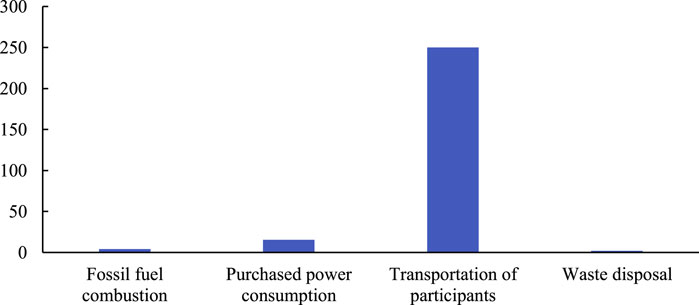
FIGURE 4. Carbon dioxide emissions from different departments of a medium-sized artwork auction (unit: ton).
4 Discussion
Technology is seen as a sustainable way to achieve a low-carbon or carbon-free environment (Sun et al., 2019). Combining virtual reality technology and artwork auction is a new form of application, which is the performance of technological development applied in the market economy. Science and technology enables the auction to break through the limitations to space and time and display the three-dimensional effect of the traditional physical exhibition through virtual and accurate technologies. It emphasizes the novelty and impact of the theme, pays attention to the combination of pictures and substance, and fully stimulates the audience’s visual, auditory, and other sensory organs. It has the characteristics of multi-sensibility, interactivity, independent selectivity, and on-the-spot feeling, which enhances the user experience and promotes the digital transformation of auctions. Then, works can be displayed more comprehensively, vividly, and realistically, which effectively improves the display effect of the works. Christie’s, a famous artwork auction house, launched a new version of its application that uses virtual reality technology to allow participants to view private art collections remotely.
According to the statistical annual report of 2020 China’s cultural relics and artworks auction market, 94% of the auctions were held online in 2020 under the background of the epidemic, and it was 2.5 times higher than that in 2019, with a turnover of 1.353 billion yuan. The scale of the pure online auction has been further improved, and online bidding is enthusiastic. The flow of participants caused a large part of the total carbon footprint of the artwork auction. In addition, the carbon dioxide emitted by the long-distance transportation of participants, whose proportion is low, accounts for the main part of the total traffic emissions of the artwork auction (Neugebauer et al., 2020). Allowing long-distance participants to switch from face-to-face participation to online video and even completely virtual artwork auctions can significantly reduce carbon emissions (Neugebauer et al., 2020; Ewijk and Hoekman, 2021; Jckle, 2021).
In order to explore the emission reduction potential of the virtual auction, this paper supposes a medium-sized artwork auction where 20%, 50%, and 30% of the participants travel by train, short-haul air, and long-distance air with the average round-trip distance of 1,200 km, 5,000 km, and 10,000 km, respectively. The whole process of the auction emits about 400 tons of carbon dioxide equivalents. The degree of virtualization is expressed by the proportion of online participants in the total number. This paper assumes that the degree of virtualization of the artworks auction will gradually increase until it is completely virtualized to calculate the emission reduction of the auction (long-distance participants will be given priority to virtualization). As shown in the Figure 5, the marginal amount of emission reduction decreases with the improvement of virtualization. When the degree of virtualization of the auction is 30%, the carbon dioxide emission of transportation is reduced by 55%. As long as the degree of virtualization of the artworks auction is 80%, the carbon dioxide emissions from transportation can almost be ignored. When all auction participants participate online, the carbon dioxide emission will only be 5%–10% of the offline artwork auction.
Since 2020, the time and space constraints and high costs caused by COVID-19 have had a significant impact on the artwork auction market, which forced the auction industry to accelerate the pace of digitalization. By creating a digital space for artwork auction to achieve interaction between products, services, and humans, the physical and time constraints of the auction industry have been broken. Christie’s annual artworks auction revenue online increased by 262%, and Phillips’, increased by 134%. However, the crown of digital transformation belongs to Sotheby’s, whose online artwork auction revenue has increased by 25% in 2019 and 440% in 2020. More than 70% of Sotheby’s artwork auctions were held online in 2020, only 30% in 2019, and new online bidders increased by more than 40%. Based on the carbon emissions in 2019, the cancellation of offline auctions and the online holding of artwork auctions in 2020 made the expectation of carbon emissions in 2020 to be only half of that in 2019. After the normalization of the epidemic, carbon emissions are expected to rebound, but it is still the mainstream trend of the auction industry that digital transformation causes emission reduction (Figure 6). Before 2025, with the rapid transformation of artwork auctions, carbon emissions will decline rapidly. However, after 2025, due to the urgent need to break through critical technologies to achieve further digital transformation, the speed of emission reduction will slow down. By 2030, the artwork auction’s carbon emissions are expected to only be 10% of those in 2019.
5 Conclusion and policy implications
Since the outbreak of the COVID-19 epidemic in 2020, most artwork auctions have been transferred online. Virtual auctions and hybrid-virtual auctions are more environmentally friendly alternatives to offline auctions. We estimated the carbon footprint and found that the traffic emission of participants, particularly composed of the traffic emission of a few long-distance participants, accounts for a large proportion of the total emission and that the transition from a face-to-face artwork auction to virtual auction can significantly reduce the carbon footprint by 90%–95%. Based on the aforementioned analysis results, we put forward the following suggestions. In a typical auction, the emission of fossil fuel combustion varies from 2.7 tons to 4.4 tons due to different fuels used. The consumption of electricity purchased in the auction will produce about 15.85 tons of carbon dioxide, and the specific emission is affected by the local power emission factors. Based on the different average round-trip distance, the carbon dioxide emissions vary significantly, ranging from 50 tons to 500 tons. The carbon dioxide emission from waste treatment is affected by the treatment method, and the emission is about 2 tons. Finally, it further predicts the carbon emissions of the auction in the rapid development of a virtual reality technology. We find that, by 2030, the artwork auction’s carbon emissions are expected to be only 10% of those in 2019. The institutional quality matters in carbon emission reduction (Sun, et al., 2022). Therefore, we proposed the following policy recommendations based on the research results.
First, the relevant departments should improve the accounting methodology of artwork auction carbon footprint, simplify the accounting process of the auction’s carbon emission, and build a carbon footprint calculator for the artwork auction market. A clear understanding of the carbon emissions in the auction’s organization process can help organizers evaluate the emission reduction potential of different links. The regulatory authorities should propose a plan to reduce the greenhouse gas emission of the activity to the greatest extent and require that all behaviors in each link, including the start-up stage, preparation stage, development stage, and ending stage, meet the emission control policy.
Second, the relevant departments build a carbon neutralization system for the artwork auction industry improving the transparency and the regulatory process of emissions. The organizers should invite third-party institutions to monitor on-site emissions and collect data. Different quantities of carbon quotas will be allocated to auctions of various sizes. The government should allocate different amounts of carbon quotas to artwork auctions of different sizes and require auctions to take the initiative to implement actions to regulate greenhouse gas emissions voluntarily and need the organizers to neutralize the actual greenhouse gas emissions through carbon offsets.
Finally, the development of the “meta-universe” and other virtual technologies should be promoted. The efficiency and experience of the auction process should be improved. Also, carbon neutralization of the artwork auction industry should be realized. So, the digital transformation should be encouraged to avoid the transportation and accommodation of participants and reduce the carbon dioxide emission of high-emission links.
Data availability statement
The original contributions presented in the study are included in the article/Supplementary Material; further inquiries can be directed to the corresponding author.
Author contributions
JC conceived and designed the study. CQ provided the data. JC and CQ wrote the manuscript. CS analyzed the results. All authors read and approved the manuscript.
Acknowledgments
The authors wish to express their sincere gratitude to the National Natural Science Foundation of China (Nos. 72074186 and 71673230), the Major Program of the National Fund of Philosophy and Social Science of China (No. 21&ZD109), and the Innovation Strategy Research Program for Soft Science of Fujian Province (No. 2021R0005), and Basic Scientific Center Project of National Science Foundation of China (No. 71988101).
Conflict of interest
The authors declare that the research was conducted in the absence of any commercial or financial relationships that could be construed as a potential conflict of interest.
Publisher’s note
All claims expressed in this article are solely those of the authors and do not necessarily represent those of their affiliated organizations, or those of the publisher, the editors, and the reviewers. Any product that may be evaluated in this article, or claim that may be made by its manufacturer, is not guaranteed or endorsed by the publisher.
References
Achten, W. M., Almeida, J., and Muys, B. (2013). Carbon footprint of science: More than flying. Ecol. Indic. 34, 352–355. doi:10.1016/j.ecolind.2013.05.025
Auruskeviciene, V., Pundziene, A., Skudiene, V., Gripsrud, G., Nes, E., and Olsson, U. (2010). Change of attitudes and country image after hosting major sport events. Eng. Econ. 66, 21. doi:10.1016/j.iref.2009.02.002
Borggren, C., Moberg, A., Raesaenen, M., and Finnvefen, G. (2013). Business meetings at a distance – decreasing greenhouse gas emissions and cumulative energy demand? J. Clean. Prod. 41, 126–139. doi:10.1016/j.jclepro.2012.09.003
Colin, B. (2016). G20 Hangzhou summit: A possible turning point for global governance. China Q. Int. Strategic Stud. 02, 327–346. doi:10.1142/s2377740016500202
Collins, A., and Cooper, C. (2017). Measuring and managing the environmental impact of festivals: The contribution of the ecological footprint. J. Sustain. Tour. 25, 148–162. doi:10.1080/09669582.2016.1189922
Desiere, S. (2015). The carbon footprint of academic conferences: Evidence from the 14th EAAE congress in Slovenia. EuroChoices 15, 56–61. doi:10.1111/1746-692x.12106
Diederichs, N., and Roberts, D. (2016). Climate protection in mega-event greening: The 2010 FIFA™ world Cup and COP17/CMP7 experiences in durban, South Africa. Clim. Dev. 8, 376–384. doi:10.1080/17565529.2015.1085361
Dillender, M. (2019). Climate change and occupational health: Are there limits to our ability to adapt? J. Hum. Resour. 56, 184–224. doi:10.3368/jhr.56.1.0718-9594r3
Dolf, M., and Teehan, P. (2015). Reducing the carbon footprint of spectator and team travel at the University of British columbia's varsity sports events. Sport Manag. Rev. 18, 244–255. doi:10.1016/j.smr.2014.06.003
Dolles, H., and Söderman, S. (2010). Addressing ecology and sustainability in mega-sporting events: The 2006 football World Cup in Germany. J. Manag. Organ. 16, 587–600. doi:10.1017/s1833367200001954
Druckman, A., and Jackson, T. (2009). The carbon footprint of UK households 1990–2004: A socio-economically disaggregated, quasi-multi-regional input–output model. Ecol. Econ. 68 (7), 2066–2077. doi:10.1016/j.ecolecon.2009.01.013
Ewijk, S. V., and Hoekman, P. (2021). Emission reduction potentials for academic conference travel. J. Industrial Ecol. 25, 778–788. doi:10.1111/jiec.13079
Filimonau, V., Dickinson, J., Robbins, D., and Huijbregts, M. A. (2011). Reviewing the carbon footprint analysis of hotels: Life Cycle Energy Analysis (LCEA) as a holistic method for carbon impact appraisal of tourist accommodation. J. Clean. Prod. 19, 1917–1930. doi:10.1016/j.jclepro.2011.07.002
Fott, P. (1999). Carbon emission factors of coal and lignite: Analysis of Czech coal data and comparison to European values. Environ. Sci. Policy 2, 347–354. doi:10.1016/s1462-9011(99)00024-6
Garcia, R., and Freire, F. (2014). Carbon footprint of particleboard: A comparison between ISO/TS 14067, GHG protocol, PAS 2050 and climate declaration. J. Clean. Prod. 66, 199–209. doi:10.1016/j.jclepro.2013.11.073
Hischier, R., and Hilty, L. (2002). Environmental impacts of an international conference. Environ. Impact Assess. Rev. 22, 543–557. doi:10.1016/s0195-9255(02)00027-6
Huang, H. C., Lai, Y. H., Chen, L. S., and Chang, C. M. (2012). Influence of international mega sport event towards cognition of economic, social-cultural and environmental impact for residents: A case study of the 2009 kaohsiung world games. Adv. Mater. Res. 524-527, 3392–3397. doi:10.4028/www.scientific.net/amr.524-527.3392
Huo, M. L., Han, X. Y., and Shan, B. G. (2013). Empirical study on key factors of carbon emission intensity of power industry. China: Electric Power.
IPCC (2021). Climate change 2014: Impacts, adaptation, and vulnerability[R/OL]. Available at: http://www.ipcc.ch/pdf/assessment-report/ar5/wg2/ar5_wgII_spm_en.pdf (Accessed 03 16, 2021).
Jckle, S. (2021). Reducing the carbon footprint of academic conferences by online participation: The case of the 2020 virtual European consortium for political research general conference. Political Sci. Polit. 52, 456–461. doi:10.1017/S1049096521000020
Kang, M., and Kang, S. (2022). Energy intensity efficiency and the effect of changes in GDP and CO2 emission. Energy Effic. 15, 8–20. doi:10.1007/s12053-021-10002-z
Lenzen, M. (2001). Errors in conventional and input-output—Based life—cycle inventories. J. Industrial Ecol. 4, 127–148. doi:10.1162/10881980052541981
Levine, M. D., and Aden, N. T. (2008). Global carbon emissions in the coming decades: The case of China. Annu. Rev. Environ. Resour. 33, 19–38. doi:10.1146/annurev.environ.33.012507.172124
Li, S., Song, Z., Yu, Y., and Jiang, T. (2021). Assessment of carbon emission in China and factors influencing the estimation: An input-output analysis. IOP Conf. Ser. Earth Environ. Sci. 776, 012010. doi:10.1088/1755-1315/776/1/012010
MaZhou, H. S. C. H., Wang, K. S., and Xiao, J. J. (2013). The calculation of product carbon footprint and optimization design. Appl. Mech. Mater. 333-335, 2156–2159. doi:10.4028/www.scientific.net/amm.333-335.2156
Neugebauer, S., Bolz, M., Mankaa, R., and Traverso, M. (2020). How sustainable are sustainability conferences? - comprehensive life cycle assessment of an international conference series in Europe. J. Clean. Prod. 242, 118516. doi:10.1016/j.jclepro.2019.118516
Shen, L., Zhao, J. A., Wang, L. M., Liu, L. T., Wang, Y., Yao, Y. L., et al. (2016). Calculation and evaluation on carbon emissionfactor of cement production in China. China: Chinese Science Bulletin.
Spalding-Fecher, R. (2011). What is the carbon emission factor for the South African electricity grid? J. Energy South. Afr. 22, 8–14. doi:10.17159/2413-3051/2011/v22i4a3225
Sproles, C. (2009). Intergovernmental Panel on climate change (IPCC). Gov. Inf. Q. 26, 428–429. doi:10.1016/j.giq.2008.10.002
Stepchenkova, S. (2013). Tourism in Brazil: Environment, management and segments. Tour. Manag. 37, 37–38. doi:10.1016/j.tourman.2013.01.006
Sun, H., Bless, K. E., Sun, C., and Kporsu, A, K. (2022). Institutional quality and its spatial spillover effects on energy efficiency. Socio-Economic Plan. Sci. 83, 101023. doi:10.1016/j.seps.2021.101023
Sun, H., Bless, K. E., Sun, C., and Kporsu, A, K. (2019). Institutional quality, green innovation and energy efficiency. Energy Policy 135, 111002. doi:10.1016/j.enpol.2019.111002
Tong, P., Zhang, Q., Lin, H., Jian, X., and Wang, X. (2020). Simulation of the impact of the emergency control measures on the reduction of air pollutants: A case study of APEC blue. Environ. Monit. Assess. 192, 116. doi:10.1007/s10661-019-8056-1
Tugcu, C. T., Ozturk, I., and Aslan, A. (2012). Renewable and non-renewable energy consumption and economic growth relationship revisited: Evidence from G7 countries. Energy Econ. 34, 1942–1950. doi:10.1016/j.eneco.2012.08.021
Wang, Q., and Zhang, F. Y. (2021). The effects of trade openness on decoupling carbon emissions from economic growth – evidence from 182 countries. J. Clean. Prod. 279, 123838. doi:10.1016/j.jclepro.2020.123838
Wigley, T., and Raper, S. (1992). Implications for climate and sea level of revised IPCC emissions scenarios. Nature 357, 293–300. doi:10.1038/357293a0
Yates, J., Kadiyala, S., Li, Y., Levy, S., Endashaw, A., Perlick, H., et al. (2022). Can virtual events achieve co-benefits for climate, participation, and satisfaction? Comparative evidence from five international agriculture, nutrition and health academy week conferences. Lancet Planet. Health 6, 164–170. doi:10.1016/s2542-5196(21)00355-7
Zen, I. S., Al-Amin, A. Q., Alam, M., E., and Doberstein, B. (2021). Magnitudes of households carbon footprint in iskandar Malaysia: Policy implications for sustainable development. J. Clean. Prod. 315, 128042. doi:10.1016/j.jclepro.2021.128042
Zhao, X., Bai, X., and Shin, H. (2021). The aspects of ecological ENVIRONMENT in host city of the winter olympic games. J-Institute 6, 83–91. doi:10.22471/value.2021.6.1.83
Zhu, Q., Peng, X., and Wu, K. Y. (2012). Calculation and decomposition of indirect carbon emissions from residential consumption in China based on the input–output model. Energy Policy 48, 618–626. doi:10.1016/j.enpol.2012.05.068
Keywords: carbon footprint, artwork auction market, network virtualization, emission factor method, IPCC
Citation: Qian C, Chen J and Sun C (2023) Carbon footprint and emission reduction potential of the artwork auction market. Front. Energy Res. 11:1029939. doi: 10.3389/fenrg.2023.1029939
Received: 28 August 2022; Accepted: 12 January 2023;
Published: 31 March 2023.
Edited by:
Xiaoqi Sun, Shenzhen University, ChinaCopyright © 2023 Qian, Chen and Sun. This is an open-access article distributed under the terms of the Creative Commons Attribution License (CC BY). The use, distribution or reproduction in other forums is permitted, provided the original author(s) and the copyright owner(s) are credited and that the original publication in this journal is cited, in accordance with accepted academic practice. No use, distribution or reproduction is permitted which does not comply with these terms.
*Correspondence: Chuanwang Sun, Y3dfc3VuQGZveG1haWwuY29t
 Chenxiang Qian1
Chenxiang Qian1 Chuanwang Sun
Chuanwang Sun